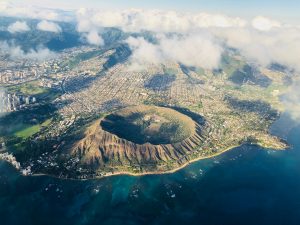Hawaii is a series of volcanic mountain peaks rising up from the depths of the Pacific Ocean. They are an isolated archipelago yet relatively easy to get to from Asia, Australia, Canada, and USA, of which they are a recognized state. The islands have a laid back Polynesian charm and tropical climate. They are renowned for their natural beauty, with plenty of wild coastlines and beaches, dramatic mountain slopes with cascading waterfalls, lava flows, and lush forests. Famous attractions include Honolulu with its Diamond Head Crater and Waikiki Beach, Kilauea Volcano, Haleakala National Park, Waimea Canyon, the Na Pali Coast, and the Hana coastal road. Activities include some world class hiking trails, some of the biggest surf-able waves in the world, and superb aquatic attractions such as kayaking, snorkeling and scuba diving at Kona. The Pacific waters that surround Hawaii are home to an astonishing number of endemic fish. Giant mantas, turtles, dolphins, and plenty of sharks inhabit the region, and humpback whales migrate here annually.

Diamond Head Crater, Honolulu
The tourism sector accounts for 20% of the local economy and welcomes over 10 million visitors annually. Yet all that came to a shuddering halt in early 2020 when the first cases of COVID-19 arrived. The first confirmed case occurred on 6 March yet it was thought that infected tourists were present as early as January of last year. The worst infected areas were Oahu and Lanai. State parks, bars and clubs were closed 17 March. A 14-day quarantine was soon imposed afterwards for international arrivals. Stay-at-home orders were also used until the end of April. Contact-tracing measures were implemented, and by May Hawaii reported the lowest rate of deaths per capita of all US states.
A staged re-opening began but a second waves of infections forced another lockdown until the end of September. Bars had again re-opened by March 2021, and the state began to impose entry to these establishments only upon proof of vaccination by June 2021. To date Hawaii has had 66,000 confirmed cases and 13,000 deaths. Although August 2021 has been the worst month of the pandemic by far in terms of case numbers, the state is still the safest place to be in the USA in terms of death rate. Vaccines began to arrive December 2020 and now over 55% of the population are fully vaccinated.
As for international arrivals, Hawaii introduced a negative NAAT test result for entry as an alternative to the quarantine regulation. This policy is still in place, but on 17 December 2020 the quarantine period was reduced to 10 days. On 15 June 2021 new arrivals were exempt from quarantine with proof of at least one vaccination shot. Beginning 8 July 2021, fully vaccinated travelers from the United States may enter Hawaii on domestic flights without pre-travel testing/quarantine. Further information on entry requirements can be found here: Hawaii Tourism Authority entry requirements![]() .
.
As stated above, Hawaii is officially a state of the USA and has achieved the best results per capita of all US states during the pandemic. Overall the USA has suffered from poor leadership and widespread belief in various conspiracy theories. Vaccine take-up has been very low compared to other developed countries, and there has been widespread resistance to any and all forms “personal liberties”. Additionally, Dr Anthony Fauci, Chief Medical Advisor to the president, has been caught lying to the public about mask use, herd immunity, and about gain of function research and its funding in China by the US government. All of this has led to a divided nation, which Hawaii no doubt has been pleased to be several thousand miles removed from.
Our Hawaii liveaboard cruises along the Kona coast of Bog Island have been running as per normal since October 2020. This is the best place in Hawaii to explore underwater lava tubes, rugged pinnacles and archways, and to encounter the megafauna for which the islands are famous.